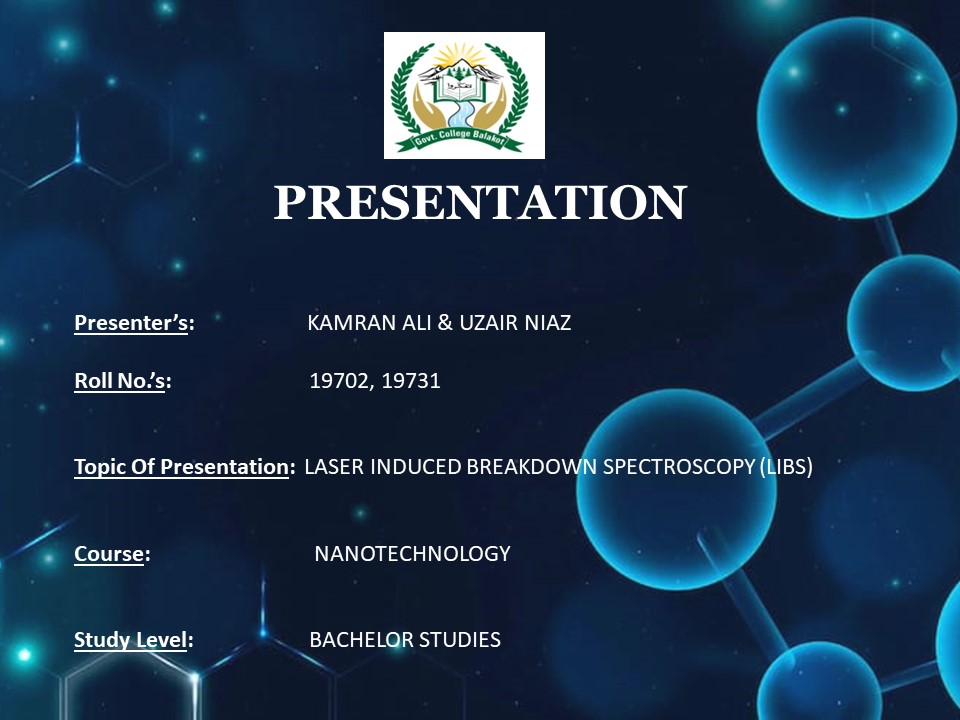LASER INDUCED BREAKDOWN SPECTROSCOPY (LIBS) - PowerPoint PPT Presentation
Title: LASER INDUCED BREAKDOWN SPECTROSCOPY (LIBS)
1
PRESENTATION
Presenters KAMRAN ALI
UZAIR NIAZ Roll No.s
19702, 19731
Topic Of Presentation LASER INDUCED
BREAKDOWN SPECTROSCOPY (LIBS)
Course
NANOTECHNOLOGY
Study Level
BACHELOR STUDIES
2
- LASER-INDUCED BREAKDOWNSPECTROSCOPY
- (LIBS)
- LIBS stands for Laser-Induced Breakdown
Spectroscopy, which is an - analytical technique used for elemental
analysis of materials. It involves - the use of a laser to generate a plasma on
the surface of a sample, and - the emission spectrum of the plasma is
then analyzed to determine the - elemental composition of the sample.
- LIBS is easily performed by focusing a highly
energetic - laser pulse onto the surface of a
solid or liquid, or into - sample volume of a liquid, gas, or
cloud of solid or liquid - particles in gas (aerosol).
- The resulting microplasma contains excited
molecular and - atomic species from the bulk sample, as
well as ablated particulates.
3
- These excited-state species emit light at unique
wavelengths. - This light can then be collected with a
spectrometer and parsed - to a computer.
- Since each element has a unique emission
spectrum, - all elements can be detected with LIBS. LIBS
requires little or no - sample preparation and can be performed
remotely and in real time.
4
- The Construction Of A LIBS
- The construction of a LIBS system typically
involves the following components - LASER
- OPTICS
- SAMPLE CHAMBER
- SPECTROMETER
- DETECTOR
- DATA ACQUISITION SYSTEM
- CALIBRATION STANDARDS
- DATA ANALYSIS SOFTWARE
- It's important to note that the construction
of a LIBS system can vary depending on the
specific application and the desired performance
characteristics. Advanced LIBS systems may
include additional features such as multiple
lasers for different excitation wavelengths,
advanced spectrometers with high-resolution
capabilities, and automated sample handling
systems.
5
- HOW DOES LIBS WORK?
- Laser Pulse A high-energy laser pulse,
typically in the ultraviolet, visible, or
near-infrared - range, is focused onto the surface of the
sample. - The laser pulse vaporizes and ablates a small
amount of material from the surface, creating a - plasma plume.
- When the short-pulse laser beam is focused
- onto the sample surface, a small volume of
- the sample mass is ablated (i.e. removed
- via both thermal and non-thermal mechanisms)
- in a process known as Laser Ablation.
- The laser energy causes the ablated material to
- rapidly expand and ionize, forming a
6
- When the laser pulse terminates, the plasma
starts to cool. - During the plasma cooling process,
- the electrons of the atoms and ions at the
excited electronic - states fall down into natural ground states,
causing the - Plasma to emit light with discrete spectral
peaks. - A spectrometer or other light collection
system is used to
7
- The collected spectrum is compared to a
- pre-existing spectral database or a
calibration - curve to determine the elemental
composition - of the sample.
- Each element in the periodic table is
associated - with unique LIBS spectral peaks.
- By identifying different peaks for the
- analyzed samples, its chemical composition
- can be rapidly determined.
- Often, information on LIBS peak intensities
- can be used to quantify the concentration
- of trace and major elements in the sample.
- With the advancement of powerful chemometric
software for LIBS data analysis, and with - steady progress in understanding laser
ablation fundamentals, todays analytical
8
Advantages Of
LIBS
- LIBS is a versatile multi-elemental technique
having many benefits. Some of the advantages are
described as - Little or no sample preparation is required
foe elemental assay . - The minute volume of the sample is vaporized
(usually between 0.1 µg - and 0.1 mg) generally considered as quasi
non-destructive method. - It has the ability to examine very hard
materials, such as ceramics, - glasses and superconductors, which are
complicated and difficult to - process, digest and dissolve.
- It has ability for direct aerosol detection
or ambient air.
9
Limitations Of LIBS
- There are some limitations which effect the
performance of this technique. Some of the
drawbacks of this spectroscopic technique are
described below - The arrangement Of the system is expensive and
highly complicated. - Suitable criteria is difficult to achieve due
to which it is known as semi- - quantitative method.
- Low precision, generally 5 to 10 percent due
to the sample - homogeneity, sample matrix, and the laser
excitation properties. - The risk of optical damage due to laser beams
of high intensity.
10
(No Transcript)
11
Thank You































